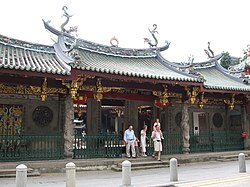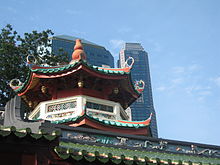Thian Hock Keng Temple
| 天福宫 | |

Thian Hock Keng Temple
|
|
| Monastery information | |
|---|---|
| Full name | Thian Hock Keng Temple |
| Order | Mazuism, Buddhism |
| Established | 1839 |
| Site | |
| Location | Telok Ayer Street |
| Country | Singapore |
| Coordinates | 1°16′51.8″N 103°50′51.1″E / 1.281056°N 103.847528°ECoordinates: 1°16′51.8″N 103°50′51.1″E / 1.281056°N 103.847528°E |
| Website | www |
| Thian Hock Keng | |||||||||||

Keng Teck Huay Pagoda
|
|||||||||||
| Simplified Chinese | |||||||||||
|---|---|---|---|---|---|---|---|---|---|---|---|
| Literal meaning | Palace of Heavenly Happiness | ||||||||||
|
|||||||||||
| Transcriptions | |
|---|---|
| Standard Mandarin | |
| Hanyu Pinyin | Tiānfú Gōng |
| Southern Min | |
| Hokkien POJ | Thian-hok-kiong |
Thian Hock Keng (literally "Palace of Heavenly Happiness"), also known as the Tianfu Temple, is a temple of Mazu ("Ma Cho Po"), a Chinese sea goddess, located in Singapore. It is the oldest and most important temple of the Hokkien (Hoklo) people in the country. Another shrine at the back is Buddhist dedicated to Guanyin, the Mahayana Buddhist bodhisattva of mercy.
Thian Hock Keng was gazetted as a national monument on 6 July 1973.
The temple originated as a small joss house first built around 1821–1822 at the waterfront serving the local Hokkien community, where seafarers and immigrants may give thanks to the Mazu for a safe sea passage on their arrival to Singapore. The temple is located on Telok Ayer Street that originally ran along the coastline before land reclamation work began in the 1880s. Starting in 1839, the temple was rebuilt with funds collected over the years and donations from the community, the largest of which was from , a Hokkien businessman. The building materials of the temple and a statue of Mazu was brought over from China, with the statue enshrined in the main hall of the temple in 1840. Some of the building materials, such as stone for the columns, timber as well as tiles were recycled from ballasts in ships. The local Indian community of Chulia Street also helped build the temple, and a statue of a man who appears to be an Indian holding a beam up at the ceiling was placed in the right wing as a reminder and gesture for their contribution. The temple was completed in 1842 at a cost of 30,000 Spanish dollars.
...
Wikipedia
